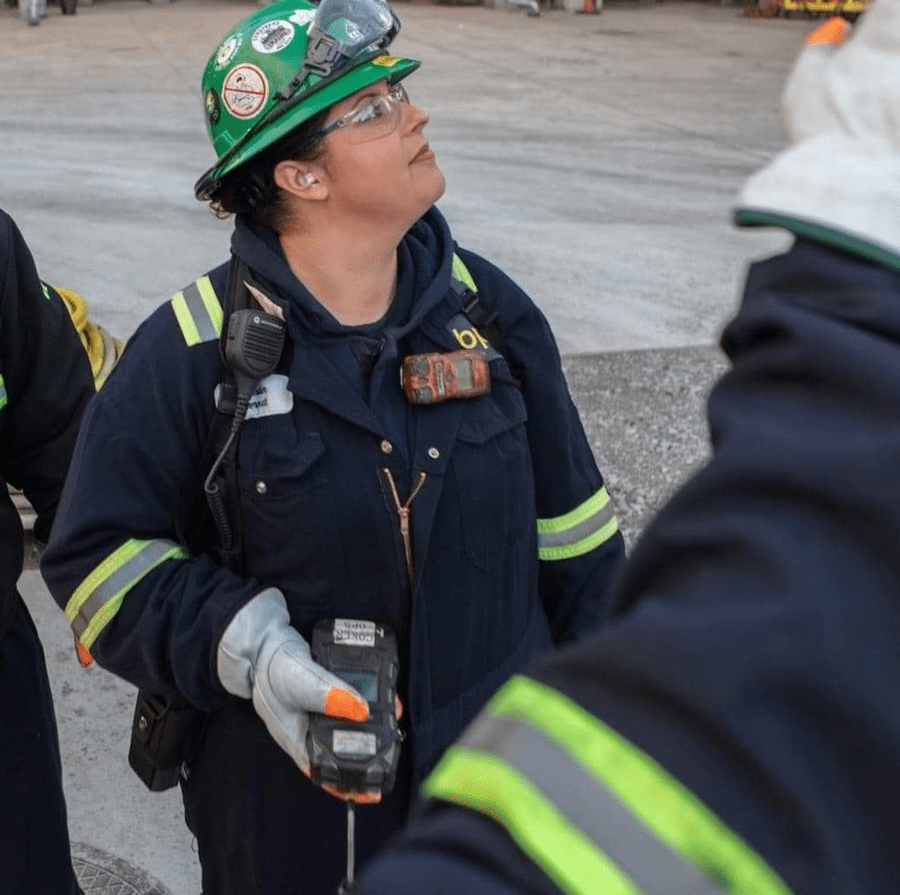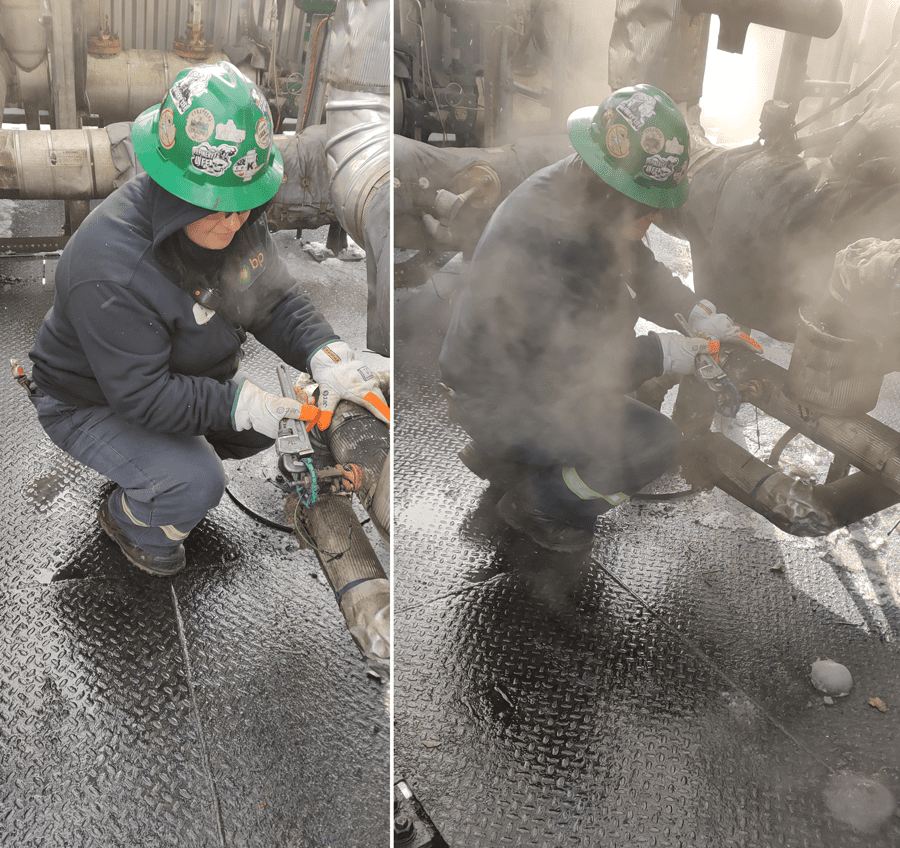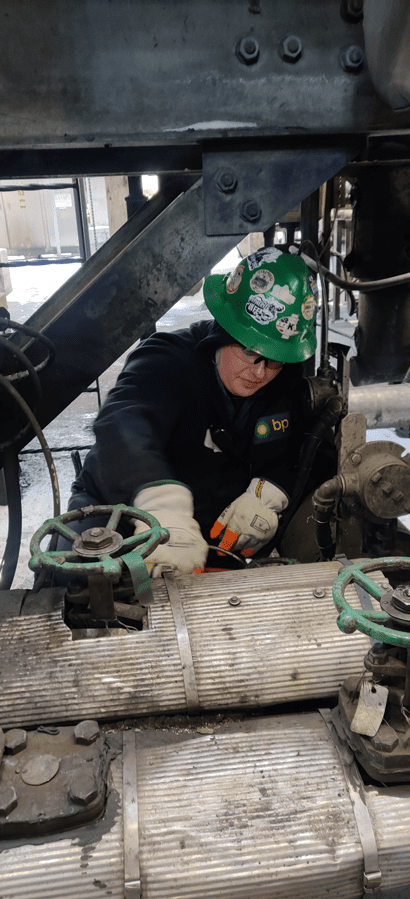2:45 a.m. First of all, who wakes up at 2:45 a.m.? It’s been eight weeks of waking up early and I can’t wait for a night shift. I leave my house around 3:30 a.m. and head off for my 40-minute drive. This gives me time to listen to some music and wake up a bit.
4:10 a.m. I arrive at a locker room that’s on the opposite side of the refinery from my unit. I hop into the van with my most favorite co-workers (shout out to all my Coker guys and gals (USW 7-1) and head down to my unit, which is Coker 2. When I get to the unit, the first thing to do is connect with whomever was working the night shift. It’s so important to look over and listen to what went on for the previous shift; it could very well affect your entire 12-hour shift. When I get to my station, I crack open my favorite energy drink and look at my workload for the day. I mean, who can survive without energy drinks?
A coker is a refinery processing unit that converts residual oil from the crude oil distillation process and converts it into lighter naphtha, light and heavy gas oils for use in gasoline and diesel production and petroleum coke, which can be used in power generation and other industrial applications. Source: bp.com.

5 a.m. I go out and make a round, as we call it, and check out all my equipment for the unit I am working that day. It’s a lot to look at, but anything can happen at any time and making sure everything is in good shape is how you can catch something before it gets too out of hand. When you work out here, you get familiar with what “normal” should look like.
6 a.m. We always have a six o’clock meeting to discuss refinery status work for the day and any other important information about the units on the coker. It’s also a time to discuss how we can safely achieve all our tasks during our shift.
8 a.m. Crafts (maintenance technicians) usually come in around this time, and this is when permits are signed and jobs are walked out with permits in hand. Also, shout-out to Coker bp crafts!

10 a.m. Making rounds throughout the day is so important to safe operations. We continually check on all the work going on to make sure safety is our highest priority.
12 p.m. Some work is finishing up and lockouts must be taken off; equipment is prepped and put back into service. Some are quick five-minute jobs, and others can take hours to prep and get back online. Luckily, we always have someone to help us because that’s how we operate. We are given certain times to switch oil into each drum. We watch every valve movement and are mindful of what the pressure and temperature should be at that exact moment. If we have a valve that does not open or close at the right time, it means starting all over again or shutting down that particular module, called a sequencer, to fix it. The sequencer controls quenching, cooling down the coke, and back warming, which is heating the empty drum for the hot oil that is going into it.

1 p.m. After the coke drums are filled, quenched and drained, they are ready to be cut. As the drum is nearing the end of the drain, our top unheading devices will open and then the bottom unheading device will open. The safety interlocks on the coker cannot be bypassed and thank goodness for that. Water valves will only open when the cutting tool is 30 feet or more into the drum. It takes approximately three to four hours to cut a drum.
2 p.m. While cutting the drum, I am constantly loading the coke out of the pit with an enormous crane. The crane scans the pit and will pick from wherever I need it to; most of the time, it picks from the spots with the most coke. After the crane picks up a bucket, it drops it into a crusher that drops it onto a belt, and it is then sent to the coke loading company, which loads it into railcars.
3-4 p.m. When the day is nearing the end, I get ready to prep my colleague on the next shift. I pay critical attention to all the details and give an informed download, sometimes getting into the most minute details. You never know when a small detail could help prevent a unit from going down. No detail should ever be overlooked. I make what’s called a shift log to report any issues on my unit, so that the person coming in knows what’s going on. When they arrive, I make a solid relief [handover to the incoming person] to make sure they understand what’s going on and that they know as much as possible about the day’s operations. I’m sure the other two females that are on my unit will agree when I say that we are all brothers and sisters and look out for one another as such. I was welcomed by the team even though I didn’t even know what a pipe wrench was when I joined. My co-workers gave me so much confidence and helped me learn every day. I don’t know what I would do without my work family.
After a long day, I hop into my car and I’m so thankful I get to go home to see my amazing husband and two beautiful little girls. I get to show them every day that a woman can do what a man can do – and more! I am proud to be a USW 7-1 “oilwoman.”
Photos Courtesy of Kristin Cernat
Kristin Cernat, 36, has been with bp for four and half years at its Whiting Refinery in Indiana. She works on the Coker unit which is split up into Coker, VRU 400 and Structure. She is qualified on all three jobs.
Oil and gas operations are commonly found in remote locations far from company headquarters. Now, it's possible to monitor pump operations, collate and analyze seismic data, and track employees around the world from almost anywhere. Whether employees are in the office or in the field, the internet and related applications enable a greater multidirectional flow of information – and control – than ever before.



